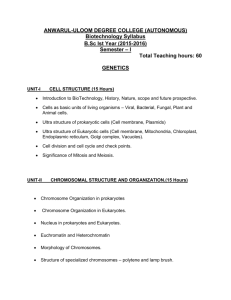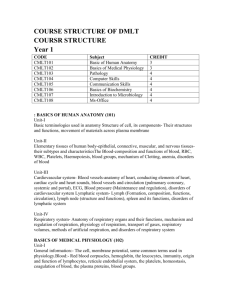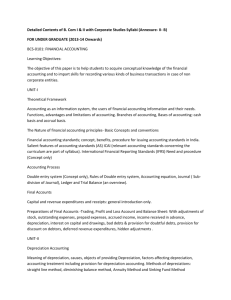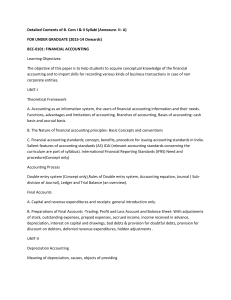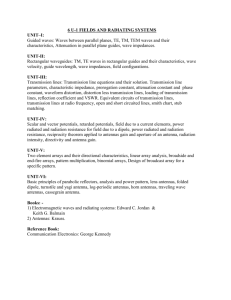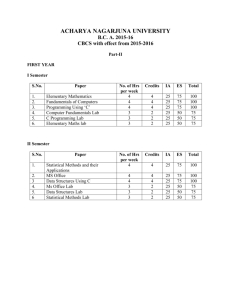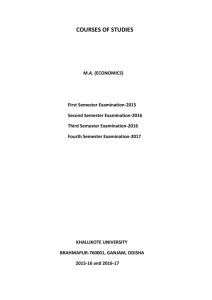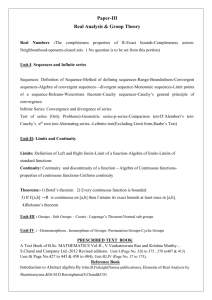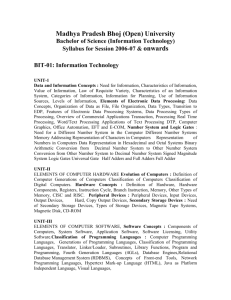Unit-I - Takshashila Career Solution
advertisement
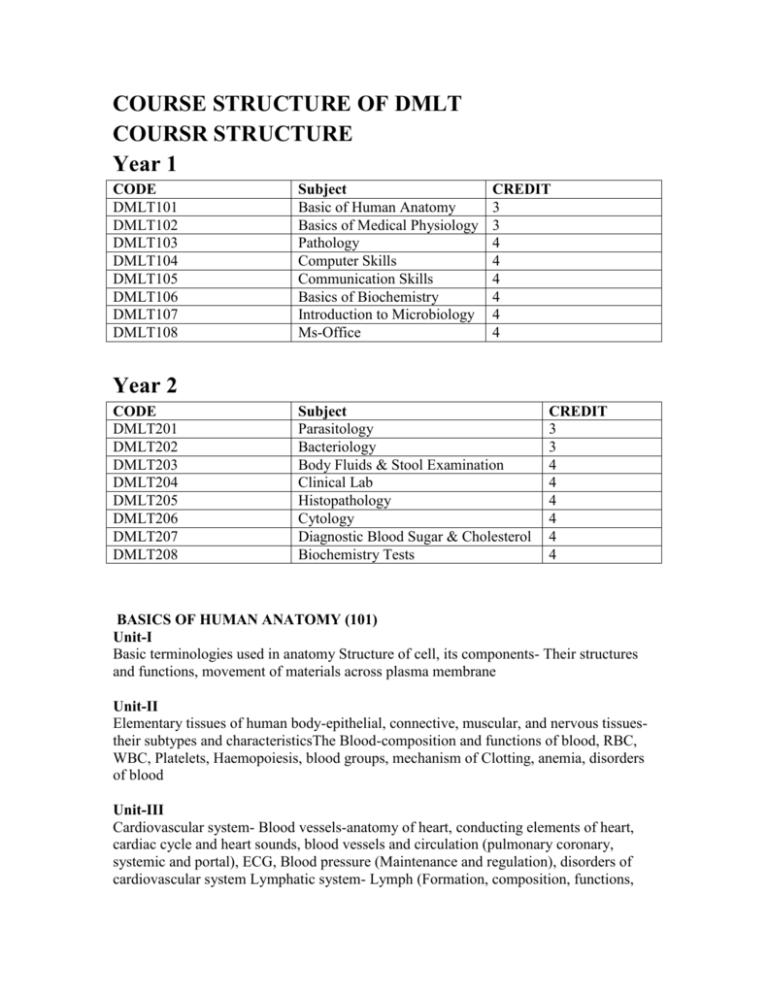
COURSE STRUCTURE OF DMLT COURSR STRUCTURE Year 1 CODE DMLT101 DMLT102 DMLT103 DMLT104 DMLT105 DMLT106 DMLT107 DMLT108 Subject Basic of Human Anatomy Basics of Medical Physiology Pathology Computer Skills Communication Skills Basics of Biochemistry Introduction to Microbiology Ms-Office CREDIT 3 3 4 4 4 4 4 4 Year 2 CODE DMLT201 DMLT202 DMLT203 DMLT204 DMLT205 DMLT206 DMLT207 DMLT208 Subject Parasitology Bacteriology Body Fluids & Stool Examination Clinical Lab Histopathology Cytology Diagnostic Blood Sugar & Cholesterol Biochemistry Tests CREDIT 3 3 4 4 4 4 4 4 BASICS OF HUMAN ANATOMY (101) Unit-I Basic terminologies used in anatomy Structure of cell, its components- Their structures and functions, movement of materials across plasma membrane Unit-II Elementary tissues of human body-epithelial, connective, muscular, and nervous tissuestheir subtypes and characteristicsThe Blood-composition and functions of blood, RBC, WBC, Platelets, Haemopoiesis, blood groups, mechanism of Clotting, anemia, disorders of blood Unit-III Cardiovascular system- Blood vessels-anatomy of heart, conducting elements of heart, cardiac cycle and heart sounds, blood vessels and circulation (pulmonary coronary, systemic and portal), ECG, Blood pressure (Maintenance and regulation), disorders of cardiovascular system Lymphatic system- Lymph (Formation, composition, functions, circulation), lymph node (structure and functions), spleen and its functions, disorders of lymphatic system Unit-IV Respiratory system- Anatomy of respiratory organs and their functions, mechanism and regulation of respiration, physiology of respiration, transport of gases, respiratory volumes, methods of artificial respiration, and disorders of respiratory system BASICS OF MEDICAL PHYSIOLOGY (102) Unit-I General information:- The cell, membrane potential, some common terms used in physiology.Blood:- Red blood corpuscles, hemoglobin, the leucocytes, immunity, origin and function of lymphocytes, reticule endothelial system, the platelets, homeostasis, coagulation of blood, the plasma proteins, blood groups. Unit-II Digestive system:- introduction to digestive system. Elementary functional anatomical considerations,the salivary glands, the stomach and its secretion, pancreas, the bile, the small intestine, movement of the alimeniary tract, gastrointestinal hormones, apud cells. Unit-III Urinary system- Anatomy and physiology of parts of urinary system, structure of nephron,formation of urine, Renin-angiotensin system, Balance (acid base, electrolyte and water), renal clearance tests and physiology of micturition, disorders of urinary system Endocrine system- Anatomy and physiology of hormones of pituitary gland, adrenal gland, parathyroid gland, pancreas, gonads (testis and ovary), disorders of endocrine system Unit-IV Reproductive system- Anatomy and physiology of various parts of male and female reproductive systems, physiology of menstruation, spermatogenesis and oogenesis, disorders of reproductive system Nervous system- Classification of nervous system, Anatomy and physiology of parts of brain (cerebellum, pons, medulla oblongata, thalamus, hypothalamus, and functional areas of cerebrum), extra pyramidal system, limbic system, Spinal cord (Structure and reflexes),cranial nerves (Names and functions), Autonomous nervous system (sympathetic and parasympathetic), fundamentals of neurotransmitters, process of neuroconduction and neurotransmission. disorders of nervous system PATHOLOGY (103) Unit-I The Cell in Health and Disease:- Introduction to Pathology, Cellular Structure and Metabolism,Etiology and Pathogenesis of Disease, Intracellular Accumulations and Disorders of Metabolism,Amyloidosis, Degenerations and Cell Death.Alimentary System Tongue - Ulcer, Tumour ,Oral Cavity - Thrush, Tumour, Oesophagus- Inflammatory Disease, Tumour, Stomach- Inflammatory Disease, Auto Immune Disease Unit-II Inflammation and Healing, Immunity and Hypersensitivity, Infection and infestation:Inflammation-Acute and Chronic, Granulomatous Inflammation, Healing, immunity and Hypersensivity, Infection and Infestation. - Intenstine Small and Large - Ulcers, Infection, - Tumour, Malabsorption.- Appendix - Inflammatory Disease Unit-III Fluid and Haemodynamic Derangements:- Derangements of Body Fluids and Electrolytes, Heamodynamic Disorders due to Deranged Blood Volume, Heamodynamic Disorders of Obstructive Nature, Ischaemia and Infarction. - Liver - Inflammatory Disease Tumours Cirrhosis Jaundice .- Gall Bladder - Inflammatory Disease Tumour - Pancreas - Inflammatory Disease Tumour Unit-IV Growth Disorders and Neoplasia:- Adaptive Disorders of Growth, General Aspects of Neoplasia, Etiology and pathogenesis of Neoplasia, Clinical Aspects of Neoplasia, Common Specific Tumours. -Central Nervous Disease - Common Disorders Respiratory Disorders - Common Disease- Kidneys - Common Disorders - Tumours - Urodynamics COMPUTER SKILLS (104) Unit-I Hardware & Software: CPU, RAM, SSD, Operating Systems, System Softwares, Application Software.Inside Computers. Computer Systems, Internet Explorer & the World wide Web Generations of Computer, Classification of Computer Unit-II Input-Output devices: Monitor, Keyboard, Mouse, System Unit, Printer, Scanner. Storage devices : Floppy disk, Hard disk, Cartridge tape, CD-ROM, Search Engines, Web Portals.Shopping Online Unit-III Printers : Dot-Matrix, Inkjet, Laserjet, Colour printer, High speed printer, Label printer, Plotters.PROGRAMMING LANGUAGE:-Compiler, Assembly Language, Machine Language, Email: Compose and send a message. Reply to a message, Working with email attachments Unit-IV Graphical user interface: Windows 3x, Program manager, Main & accessories program groups,Multitasking, Windows Help: Search, Index. Help Online Subject: COMMUNICATION SKILLS (105) Unit-I Basic Skills: - Listening, Speaking, Reading and Writing. Comprehension: - Reading Comprehension,Passages, Poems. Unit-II Listening Comprehension: - Talks, Reports, Poems Writing Skills: - Paragraph Writing, Composition Writing, Report Writing, Application & Letter Writing Unit-III Grammar: - Simple, Compound and complex sentences, Co-ordinate clause (with, but or either-or,Neither-Nor otherwise or else), Subordinate clauses-noun clauses-as subjects object and complement:Relative Clauses (restrictive and non-restrictive clauses). Adverb clauses (open and hypothetical,Comparative Clauses Unit-IV Simple present, progressive and present perfect, simple past, progressive and past perfect, indication of futurity, the passive (Sample present and past, present and past perfect and ‘to’ infinitive structure), Reported Speech: - (I) Declarative sentences, (ii) Imperatives (iii) Interrogatives –question,Yes/No Questions, Exclamation sentences, Models (will, shall, should, would, ought to, have to/have got to, can, could, me-might and need), Verb structures (infinitives and gerundial) Subject: BASICS OF BIOCHEMISTRY (106) Unit-I Preliminary Techniques in Biochemistry - Animal models - Choice of animals, Types of Studies, Mutant Organisms, Cultured Cells, Plant as models.Cell Fractionation Techniques - Cell lysis, differential and density gradient centrifugation, Salting in, Salting out, Dialysis, Ultrafiltration. Chromatographic Techniques - Principles and Applications of Paper, TLC, Adsorption, Ion exchanges,Gel filtration, Affinity, GLC, Chromato focusing, HPLC, FPLC. Unit-II Electrophoretic Techniques - Polyacrylamide gel electrophoresis, SDS-PAGE, Agarose gel Electrophoresis Separation of Proteins, Lipoporteins, Nucleic acids, Visualizing separated components- staining, Fluorescent techniques Isoelectric focusing, pulsed field electrophoresis, High voltage electrophoresis, Capillary Electrophoresis, Isotachophoresis. Ultra Centrifugation - Construction of preparative and analytical ultra centrifuge, Svedberg's constant,Sedimentation velocity and Sedimentation equilibrium Schleiran optics. Unit-III Isotopic Tracers - Heavy isotopes and radio isotopes theory and construction of mass spectrometer.Ionization, fragmentation, m/e, Time of flight, MALDI and ESI. Radioisotopes in Biology - 3H, 14C, 32P, 131I, 35S, concept of half life, decay constant, detection and quantitation - GM counter and scintillation counter, solid and liquid scintillation. Specific activity,Carrier free isotope, Isotope dilution techniques autoradiography. Synthesis of Isotopically labeled glucose (Glcuose 1-14C and uniformely labeled glucose) acetate (1-C14 and 2-C14) Leuiene, ATP (?-P32 and ?-P32). Determination of position of labeling Unit-IV Spectroscopic Techniques - Colourimetry, Spectrophotometry, Fluorimetry. Principles Beer-Lambert's Law, Limitation, Extinction Coefficient. Application.X-ray Crystallography - Protein crystals, Bragg's law, unit cell, Isomorphous replacement, Fiber pattern of DNA Physical methods of determining size shape and structure of molecules :Magnetic Resonance - NMR and ESR - Principles and Applications. Vibration Spectra IR and Raman - Principles and Applications.Light Scattering - Determination of size and shape of macromolecules.Polarized Light - Plane and circularly polarized light. CD, Applications of CD. INTRODUCTION OF MICROBIOLOGY (107) UNIT – I History of Microbiology and Microscopy Meaning, definition and history of Microbiology, Importance and applications of Microbiology.Principles of microscopy – bright field, dark field, phase-contrast, fluorescent and electron microscopy (SEM and TEM). Ocular and stage micrometers.Size determination of microorganisms.Principles and types of stains - Simple stain, differential stain, negative stain,structural stains spore, capsule, flagella. hanging-drop method. UNIT – II Microbiological Techniques Sterilization and disinfection techniques,Principles and methods of sterilization., Physical methods -autoclave, hot-air oven, pressure cooker, laminar air flow, filter sterilization., Radiation methods – UV rays, gamma rays, ultrasonic methods., Chemical methods - Use of alcohols, aldehydes, fumigants,phenols, halogens and hypochlorites. Phenol coefficient., Isolation of pure culture techniques -Enrichment culturing, dilution-plating, streak- plate, spread-plate and micromanipulator.,Preservation of microbial cultures - sub culturing, overlaying cultures with mineral oils, lyophilization, sand cultures, storage at low temperature. UNIT – III Biology of Prokaryotic and Eukaryotic Microorganisms Outline classification of living organisms: hackle, Whittaker And Carl Woese systems., Place of microorganisms in the living world., Differentiation of prokaryotes and eukaryotes., Prokaryotes -General characteristics of bacteria, archaebacteria, rickettsias, mycoplasmas, cyanobacteria and actinomycetes., Outline classification for bacteria as per the second edition of Bergey's Manual of Systematic Bacteriology (up to order level Structure and multiplication of lambda bacteriophage.Eukaryotes - General characteristics and classification (up to the order level) of eukaryoticmicroorganisms Protozoa, microalgae, molds and yeasts. UNIT – IV Biomolecules of microorganisms., Outline classification and general characteristics of carbohydrates (monosaccharide , disaccharides and polysaccharides)., General characteristics of amino acids and proteins. Structure of nitrogenous bases, nucleotides, nucleic acids. Fatty acids (saturated and unsaturated) and lipids (spingolipids, sterols and phospholipids). hydrogen ion concentration in biological fluids, ph measurement. Types of buffers and their use in biological reactions. Principle and application of colorimeter and chromatography (paper And Thin -layer). MS-OFFICE (108) Unit-I MS Word : Creating documents, Formatting, Auto text, Auto correct, Tables, Page setup, Printing Working with Word Basics, Creating and Editing Business Letters , Creating a Memorandum and a Press Release, Creating a Simple Report Unit-II Object linking & embedding, Spell check, Thesaurus, Mail merge, Word art, Adding Clip Art, Sound, and Animation setup, Page setup, Printing, Editing, Viewing. Unit-III MS Excel : Creating workbooks & worksheets, Formulas & functions, Linking workbooks & worksheets, Cell references, Formatting, Creating charts, Data lists, Printing Worksheets, Working with Formulas and Functions, Formatting the Contents of Cells, Changing the Appearance ofWorksheets, Discovering the Magic of Excel Charting Unit-IV MS Power Point : Creating slides with different layouts and templates, Inserting charts, Tables,Organisation charts, Pictures, Running a screen show, Working with Tables Creating and Delivering a Presentation, Designing the Presentation, 2nd year PARASITOLOGY (201) Unit-I PROTOZOA:-Classification, Parasitism in Perspective: Why study parasites? kinds of parasites & kinds of host, Protozoa: Phylum Sarcomastigophora, Protozoa: PhylumApicomplexa , Protozoa: Phylum Ciliophora, Phylum Platyhelminthes, digenetic trematodes Unit-II Malarial parasite; Eishmania, Platyhelminthes: monogeneans, Platyhelminthes: cestodes, Nematodes: form, function, and reproduction, Nematodes: life cycles; Trichurids, Strongyloids,Nematodes: Do you like sushi? Oxyurida, Ascaroids, Filaroids Unit-III Amoeba ; Giardia ; Trichomona, Acanthocephalans: form, function, reproduction, and humans,Parasitism in other metazoan groups, Parasite Populations: internal factors affecting population.structure, Parasite Biogeography: factors affecting geographical distribution Unit-IV Parasites as biological markers.Evolution of host–parasite associations, Fasciola hepaticaFasciola gigantic, Clonorchis sinensis,Microspora, Hemosomatic Protozoa, Free living Amoeba BACTERIOLOGY (202) Unit-I Culturing environmental samples (air-exposure plates and simple swabbing).Gaining proficiency with the microscope. Simple and differential staining methods including gram,capsule, acid-fast and endospore stains.Basic pure culture procedures including transfer techniques and streak plates. Quantitative Microbiology I: The plate count method. Microbial count of hamburger – “total” and gram-negative, Introduction to nutritional requirements and bacteriological media. Requirements of certain bacteria for growth factors. Alteration of bacterial characteristics due to changes in the environment. Unit-II Basic Catabolism I: Aerobic respiration and fermentation and their role in the test for “oxygen relationship” as per the Bergey’s Manual definitions; correlation of oxygen relationship designations with related physiological processes in bacteria. A study of the bacterial growth curve with determination of the growth rate of an E. coli culture Microscopic and cultural methods for the determination of bacterial motility. Quantitative Microbiology II: The Most Probable Number (MPN)method. Bacteriological examination of water: Quantitation of “total” bacteria; enrichment,detection, isolation and identification of coliforms. Unit-III Basic Catabolism II: Anaerobic respiration as demonstrated by the test for nitrate reduction.Characterization, Differentiation and Identification of Bacteria: Comparative morphology and physiology of selected species and an introduction to base sequencing and phylogenetic trees.Detection and isolation of mutants and recombinants, Quantitation of bacteriophages and use of bacteriophages to assist bacterial identification. Determination of susceptibility of bacteria to various antibiotics.Principles of enrichment and isolation of bacteria from natural sources.Consideration of microbial cycling of elements – particularly N, C, S and O. Isolation of antibiotic-producing, endosporeforming and nitrogen-fixing bacteria from soil.Isolation of anoxygenic photosynthetic bacteria from water samples. Unit-IV Basic Catabolism III: Anoxygenic phototrophy with a comparison to oxygenin phototrophy. Brief study of Staphylococcus, Streptococcus and Neisseria including their isolation and the tests for hemolysis, coagulase and oxidase, Isolation and identification of enteric bacteria including the use of serology in the identification of Salmonella. (Clinical procedures are emphasized along with the use of correct and current taxonomic terminology.),Basic principles concerning pH-based differential media and the formulation of such media to distinguish certain physiological types of bacteria. BODY FLUIDS AND STOOL EXAMINATION (203) Unit-I Urine analysis :-Methods of collections, routine urine examination ,microscopic examination ,evaluation of renal function tests. Unit-II BODY FLUIDS :- Collection of c.s; physical examination ; chemical examination ; cell count ;bacteriological examination ; differential diagnosis . Unit-III Stool examination:- Normal appearance and composition ; collection of specimen Unit-IV Physical examination ; microscopic examination ; protozoa ; Helminthic ova Clinical lab(204) In this lab session student will observe and test the sample of stool and urine for different diseases under the guidance of a supervisor. HISTOPATHOLOGY (205) Unit-I Introduction to histology and histopathology, techniques in histopathology, Types of Biopsy,Registration, labeling and recording of biopsy reports, Identification and labeling of specimens,fixation of specimens before grossing ; grossing of specimens Unit-II Basic principles of grossing in histopathology , Fixatives Various types and their importance, Fixation.including microwave, Freeze drying technique, decalcification, frozen sections, Introduction to autopsy techniques, Dispatch of autopsy specimen for Histopathological Examination, FNAC Unit-III Processing of tissue specimens ; Embedding of tissue specimen ; cutting of tissue specimen, Tissue histology processing include Micro wave, Microtomy, Microscopy (light, polarizing, phase contrast),Micrometry, In situ hybridization and FISH techniques, Elementary cytogenetics, Museum specimen preservation, Method cytology Processing (Millipore, Cytospin), Embalming Unit-IV Routine staining of procedures ; Staining, H & E, PAS, Van Geison, Verhoeff’s, Reticulin, Masson’s Trichrome stain, Grocott, Congo red, AFB (for Tuberculosis & Leprae) Gram’s stain Stains for fungi, glycogen, melanin, inclusion bodies, neurons and neurogliaDehydration, clearing and decalcification, Impregnation and embedding of paraffin and sliding,Papanicoulaou staining, Immunohistochemistry Cytology (206) Unit-I Introduction, Fine needle aspiration cytology, Papanicolou method for cytologic smears Cytology: General properties of living organisms; chemistry of the cells; cellular membranes;cytoskeleton Unit-II Endoplasmic reticulum; Golgi body; lysosomes; nuclear envelope; chromatin and chromosomes;mitosis; meiosis. Outline of Embryology: Gametogenesis; reproductive cycle; fertilisation; cleavage; a model of gastrulation Unit-III Plant cell, structure and function. Prokaryotic and Eukaryotic cells. Cell wall, structure and chemistry.Functions of cell wall. Plasma membrance - structure, chemistry and function. Cell Organelles: Structure, function and origin of the following: Endoplasmic reticulum Golgi complex Lysosomes Mitochondria Plastids Ribosomes Unit - IV Nucleus -- Structure and function. Nucleolus - Structure and function. Chromosome - Structure and function. Eucbromatin and heterochromatin. Giant chromosomes, polytene and lainbrush. Nucleic acids. Molecular structure and function of DNA and RNA. Replication. Cell inclusions (non-living) Cell divisions: Mitosis and Meiosis. DIAGNOSTIC BLOOD SUGAR & CHOLESTEROL (207) Unit-I Estimation of blood sugar and cholesterol Unit-II Estimation pf blood sugar Unit-III Glucose Toleranee test Unit-IV Estimation of serum cholesterol BIOCHEMICAL TESTS (208) Unit-I Tests to Distinguish between aerobic and anaerobic breakdown of carbohydrate Unit-II Fermentation reactions ; tests for specific breakdown products Unit-III Ability to use a specific substrate ; tests for specific breakdown products and amino acids Unit-IV Tests for production of enzymes
